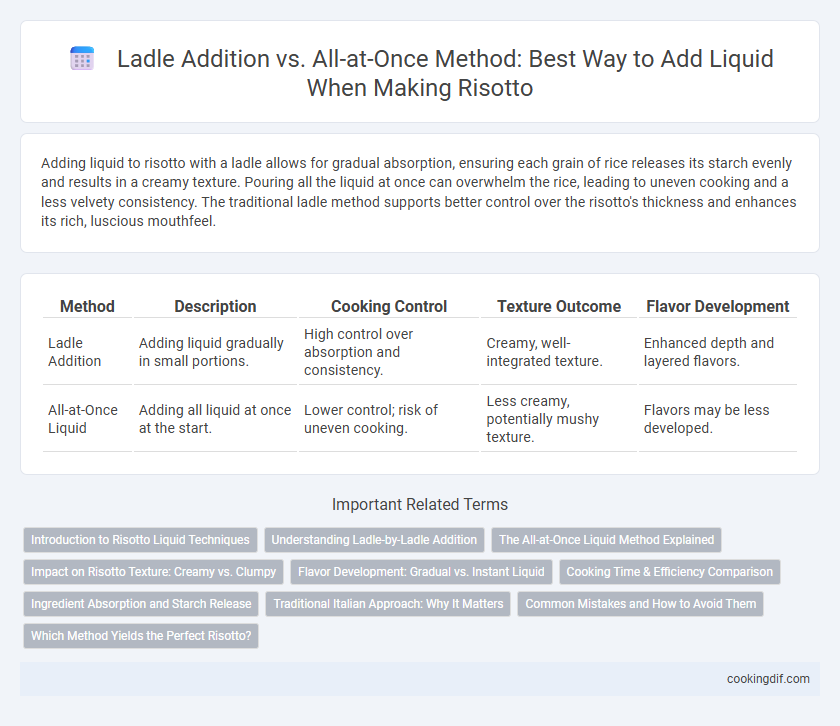Adding liquid to risotto with a ladle allows for gradual absorption, ensuring each grain of rice releases its starch evenly and results in a creamy texture. Pouring all the liquid at once can overwhelm the rice, leading to uneven cooking and a less velvety consistency. The traditional ladle method supports better control over the risotto's thickness and enhances its rich, luscious mouthfeel.
Table of Comparison
| Method | Description | Cooking Control | Texture Outcome | Flavor Development |
|---|---|---|---|---|
| Ladle Addition | Adding liquid gradually in small portions. | High control over absorption and consistency. | Creamy, well-integrated texture. | Enhanced depth and layered flavors. |
| All-at-Once Liquid | Adding all liquid at once at the start. | Lower control; risk of uneven cooking. | Less creamy, potentially mushy texture. | Flavors may be less developed. |
Introduction to Risotto Liquid Techniques
Ladle addition in risotto involves gradually adding warm broth one ladle at a time, allowing each portion to absorb fully, which helps achieve a creamy, al dente texture by controlling starch release from Arborio rice. In contrast, the all-at-once liquid method requires adding the entire amount of broth at once, leading to a different consistency and faster cooking process but with less control over texture development. Understanding these techniques is essential for mastering risotto's signature creamy consistency influenced by the slow starch gelatinization and liquid absorption.
Understanding Ladle-by-Ladle Addition
Ladle-by-ladle addition in risotto involves gradually incorporating warm broth in small portions, allowing each ladleful to be absorbed fully before adding more, which enhances the rice's creamy texture and starch release. This method ensures precise control over cooking, preventing over-saturation and promoting optimal absorption for perfect al dente grains. Compared to all-at-once liquid addition, ladle-by-ladle technique offers superior flavor development and consistent consistency throughout the dish.
The All-at-Once Liquid Method Explained
The All-at-Once Liquid method involves pouring the entire amount of broth into the risotto at the beginning of cooking, allowing the rice to absorb the liquid steadily without repeated stirring. This technique contrasts with the traditional ladle addition, where broth is gradually added in increments, requiring constant attention. While the all-at-once method simplifies preparation and reduces hands-on time, it may yield a creamier but less textured risotto compared to the ladle addition technique.
Impact on Risotto Texture: Creamy vs. Clumpy
Adding liquid to risotto by ladle ensures gradual starch release, resulting in a creamy, velvety texture perfect for traditional risotto. Pouring all liquid at once risks uneven starch absorption, causing clumpy, watery results that compromise the dish's smooth consistency. Controlled ladle addition enhances starch gelatinization and emulsification, producing the signature luxurious mouthfeel of authentic risotto.
Flavor Development: Gradual vs. Instant Liquid
Ladle addition in risotto allows gradual absorption of liquid, promoting starch release and enhancing creamy texture while deepening flavor complexity through slow flavor integration. All-at-once liquid results in immediate starch gelatinization, producing a less nuanced taste and firmer texture due to limited gradual flavor development. The step-by-step ladle method optimizes flavor layering, creating a richer, more balanced risotto experience.
Cooking Time & Efficiency Comparison
Ladle addition of liquid in risotto involves gradually adding hot broth in small increments, allowing starch release that creates a creamy texture but requires continuous stirring and typically extends cooking time to 18-20 minutes. The all-at-once method adds the entire liquid quantity at once, reducing active cooking time and stirring but often results in a less creamy, less evenly cooked risotto due to insufficient starch extraction. Comparing efficiency, ladle addition demands more attention and effort, while all-at-once offers speed at the cost of traditional consistency and texture quality.
Ingredient Absorption and Starch Release
Ladle addition in risotto promotes gradual absorption of liquid, allowing rice grains to swell evenly and release starch steadily, resulting in a creamy texture. Adding all liquid at once can overwhelm the rice, reducing controlled starch release and causing uneven cooking or a less cohesive consistency. Controlled ladle-by-ladle incorporation maximizes ingredient absorption and optimal starch gelatinization for the signature risotto creaminess.
Traditional Italian Approach: Why It Matters
The traditional Italian approach to risotto emphasizes ladle addition of warm broth, promoting gradual starch release and achieving the dish's signature creamy texture. Adding liquid incrementally allows the rice to absorb flavors evenly, enhancing depth and preventing overcooking. This meticulous technique underscores risotto's authentic culinary identity and distinguishes it from quicker, less nuanced methods like the all-at-once liquid addition.
Common Mistakes and How to Avoid Them
Adding all the liquid at once can lead to uneven cooking and a mushy texture, while ladle-by-ladle addition promotes gradual starch release for creamy, perfectly cooked risotto. A common mistake is rushing the process by dumping in too much broth too soon, causing the rice to overcook or become gummy. To avoid these issues, pour the liquid slowly and allow each addition to be fully absorbed before adding more, ensuring consistent texture and flavor.
Which Method Yields the Perfect Risotto?
Ladle addition method yields the perfect risotto by gradually releasing hot broth, allowing arborio rice to absorb liquid slowly, releasing its starch for creamy texture. All-at-once liquid method risks uneven cooking and a less creamy risotto due to rapid liquid absorption and starch release. Professional chefs highly recommend ladle addition for controlled cooking consistency and optimal mouthfeel.
Ladle Addition vs All-at-Once Liquid for adding liquid Infographic

 cookingdif.com
cookingdif.com